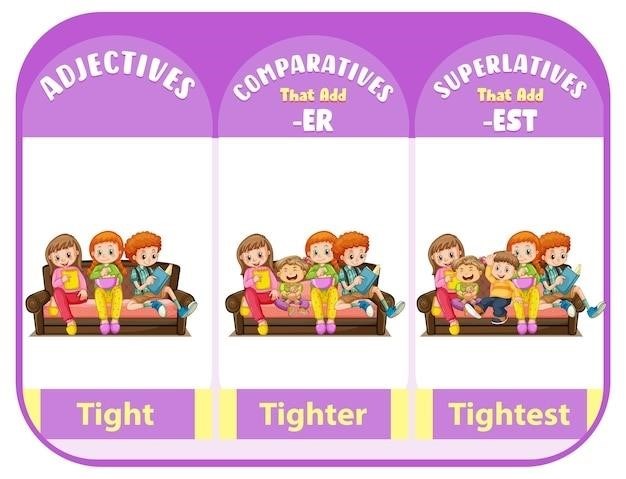autism spectrum rating scale pdf
Autism Spectrum Rating Scales (ASRS)⁚ A Comprehensive Overview
The ASRS is a nationally standardized, norm-referenced scale assessing autism spectrum disorder (ASD) symptoms and behaviors in children and adolescents aged 2-18. It’s a multi-informant measure, utilizing parent and teacher reports to enhance diagnostic accuracy and guide intervention strategies. Available forms cater to various age groups, offering both full and short versions for efficient screening and comprehensive evaluation.
The Autism Spectrum Rating Scales (ASRS), developed by Goldstein and Naglieri (2009, 2013a), stand as a pivotal instrument in the assessment of Autism Spectrum Disorder (ASD). Designed for children and adolescents aged 2 to 18 years, the ASRS offers a standardized, norm-referenced approach to identifying characteristic symptoms and behaviors associated with ASD. This multi-informant measure leverages the perspectives of parents and teachers, providing a comprehensive view of the child’s functioning across various domains. Unlike some assessment tools that focus on specific aspects of ASD, the ASRS aims for a holistic evaluation, encompassing social interaction, communication patterns, unusual behaviors, and sensory sensitivities. The ASRS’s utility extends beyond diagnosis, proving valuable in treatment planning, intervention monitoring, and evaluating treatment efficacy. The scale’s design facilitates a streamlined assessment process, contributing to efficient clinical decision-making. The availability of both full and shorter versions caters to diverse needs, whether a thorough evaluation or a quick screening is required. The ASRS’s widespread use and established psychometric properties solidify its position as a significant tool in ASD assessment.
Age Ranges and Available Forms
The ASRS caters to a broad age spectrum, encompassing children and adolescents from 2 to 18 years old. This wide age range is accommodated through distinct forms tailored to specific developmental stages. For younger children (ages 2-5), separate parent and teacher/childcare provider versions are available, recognizing the unique perspectives and observational capabilities of these informants at this age. These forms focus on behaviors typically observed in preschool-aged children. For older children and adolescents (ages 6-18), the ASRS also provides parallel parent and teacher/childcare provider forms, adjusted to capture behaviors relevant to elementary and high school students. Furthermore, to enhance efficiency, short forms are available for both age groups. These condensed versions maintain the core elements of the assessment but reduce the response burden, making them suitable for screening purposes or for monitoring treatment progress over time. The availability of these various forms ensures that the ASRS can be effectively utilized across the entire target age range, adapting to the developmental characteristics and behavioral presentations of individuals within each group. The use of parallel forms for parents and teachers allows for a more comprehensive and nuanced understanding of the individual’s behaviors across various settings.
ASRS Scoring and Interpretation
The ASRS utilizes a 5-point Likert scale, where raters (parents, teachers, or other caregivers) indicate the frequency of observed behaviors. Each item reflects a specific characteristic associated with ASD. Responses range from “Never” to “Almost Always,” providing a quantitative measure of the presence and severity of each symptom. The scoring process involves summing the responses across various scales within the ASRS, generating individual scores for different symptom domains. These scores are then compared to normative data, enabling a comparison of the individual’s profile to a representative sample of children and adolescents. This comparison helps determine whether the individual’s scores fall within the typical range or suggest a deviation indicative of ASD. While specific cutoff scores may vary depending on the ASRS version and age group, the interpretation considers the overall pattern of scores across different domains. Clinicians interpret the results, considering the individual’s developmental history, other assessment findings, and clinical observations to reach a comprehensive diagnostic conclusion. The ASRS does not provide a diagnosis in isolation, but it contributes significantly to the diagnostic process by quantifying the severity of ASD-related behaviors.
Reliability and Validity of the ASRS
The psychometric properties of the ASRS, crucial for its clinical utility, have been extensively studied. Reliability, indicating the consistency of the measure, is supported by evidence of high internal consistency (Cronbach’s alpha) across various scales. This suggests that the items within each scale effectively measure the same underlying construct. Test-retest reliability studies have also demonstrated stability over time, indicating that scores remain consistent when administered repeatedly to the same individuals. Validity, assessing whether the ASRS measures what it intends to measure, is supported by its strong correlation with other established measures of ASD symptoms. Studies comparing ASRS scores to clinical diagnoses have shown high sensitivity and specificity, meaning the ASRS accurately identifies individuals with ASD while minimizing false positives. The ASRS’s ability to differentiate between individuals with ASD and those without is further validated by its discriminant function analysis, which demonstrates accurate prediction of group membership. The concurrent and predictive validity of the ASRS is further supported by its correlation with other clinical measures and its ability to predict future outcomes, such as the response to treatment interventions. These extensive psychometric evaluations demonstrate the ASRS’s reliability and validity, making it a valuable tool in assessing and understanding ASD.

Clinical Applications of the ASRS
The Autism Spectrum Rating Scales (ASRS) offers a versatile tool with diverse applications in clinical settings. Its primary use lies in aiding the diagnostic process of Autism Spectrum Disorder (ASD) in children and adolescents. By providing a standardized and comprehensive assessment of ASD symptoms, the ASRS assists clinicians in making informed diagnostic decisions, differentiating ASD from other conditions presenting similar symptoms. Beyond diagnosis, the ASRS plays a vital role in treatment planning. The detailed information gathered allows clinicians to tailor intervention strategies to the individual’s specific needs and challenges. The scale’s ability to identify specific areas of difficulty, such as social interaction, communication, or repetitive behaviors, enables the creation of targeted therapeutic plans. Furthermore, the ASRS facilitates ongoing monitoring of treatment effectiveness. By administering the scale at various points during treatment, clinicians can track progress, adjust interventions as needed, and measure the overall impact of therapeutic efforts. This continuous assessment ensures optimal outcomes and allows for timely modifications to maximize treatment efficacy. The ASRS’s multi-informant approach, incorporating perspectives from parents and teachers, provides a holistic understanding of the individual’s functioning, further enhancing the effectiveness of clinical interventions.
ASRS in Diagnostic Processes
The ASRS significantly contributes to the diagnostic process for Autism Spectrum Disorder (ASD). Its standardized format and norm-referenced scores provide objective data, minimizing subjective biases often present in traditional assessments. The ASRS’s comprehensive coverage of ASD symptoms, encompassing social communication, repetitive behaviors, and sensory sensitivities, allows for a thorough evaluation of various ASD manifestations. The multi-informant approach, involving input from both parents and teachers, provides a more complete picture of the child’s behavior across different environments. This reduces the potential for inaccurate diagnoses based solely on observations in a single setting. The ASRS’s structured format ensures consistency, reducing variability between assessors and improving the reliability of diagnostic conclusions. The clear scoring guidelines and established norms enable clinicians to confidently interpret results and compare them to a representative population. This aids in distinguishing between typical development and ASD symptoms. While the ASRS is a valuable tool, it’s crucial to remember it should be used in conjunction with other clinical observations, developmental history, and professional judgment to reach a comprehensive diagnosis. The ASRS enhances diagnostic accuracy but isn’t a standalone diagnostic instrument.
ASRS and Treatment Planning
The Autism Spectrum Rating Scales (ASRS) plays a vital role in guiding the development of effective and individualized treatment plans for children and adolescents diagnosed with Autism Spectrum Disorder (ASD). By providing a detailed profile of the child’s specific strengths and challenges across various domains, the ASRS informs the selection of appropriate therapeutic interventions. The scale’s identification of particular symptom areas – such as social interaction difficulties, repetitive behaviors, or sensory sensitivities – allows therapists to target specific areas needing improvement. This targeted approach ensures that treatment plans are tailored to address the individual’s unique needs, maximizing the effectiveness of interventions. For instance, if the ASRS highlights significant challenges in social communication, the treatment plan might prioritize social skills training or augmentative and alternative communication strategies. Similarly, if repetitive behaviors are prominent, interventions focused on behavior modification or habit reversal might be emphasized. The ASRS’s ability to track progress over time makes it an invaluable tool for monitoring treatment efficacy and adjusting interventions as needed. This data-driven approach ensures that treatment plans remain relevant and responsive to the evolving needs of the child throughout their journey.

Using the ASRS for Intervention Monitoring
The ASRS proves invaluable in tracking a child’s progress throughout their intervention journey. Its standardized format allows for consistent and objective measurement of changes in behavior and symptoms over time. By administering the ASRS at regular intervals—for example, every three to six months—clinicians and educators can monitor the effectiveness of implemented interventions. This repeated assessment allows for a clear visualization of improvement or lack thereof in various domains, such as social interaction, communication, and adaptive behaviors. If progress is not as expected, the ASRS data can inform necessary modifications to the intervention plan. This might involve adjusting the intensity of therapy, altering therapeutic approaches, or introducing new strategies. The ASRS’s sensitivity to change enables early detection of setbacks or plateaus, allowing for timely intervention adjustments, thus ensuring the best possible outcomes for the child. Furthermore, the data collected through repeated ASRS assessments can be used to demonstrate the impact of interventions to families, school officials, and other stakeholders, providing tangible evidence of progress and justifying continued support.
Comparison with Other Autism Assessment Tools
The ASRS distinguishes itself from other autism assessment tools through its comprehensive approach and multi-informant design. Unlike some assessments focusing solely on behavioral observations or parent reports, the ASRS integrates perspectives from both parents/caregivers and teachers/childcare providers. This multifaceted perspective offers a more holistic understanding of the child’s functioning across different environments. Compared to tools like the Childhood Autism Rating Scale (CARS), which emphasizes clinical judgment, the ASRS provides standardized scores and norms, facilitating objective comparisons across individuals and treatment phases. While instruments like the Autism Diagnostic Observation Schedule (ADOS) involve direct observation, the ASRS offers a convenient and cost-effective alternative, particularly suitable for large-scale screenings or longitudinal monitoring where repeated administrations are necessary. The ASRS’s strength lies in its ability to provide a quantitative measure of symptom severity, complementing qualitative data from other assessment methods. This combined approach provides a more nuanced and comprehensive picture of the child’s autism spectrum disorder characteristics.
Strengths and Limitations of the ASRS
The ASRS boasts several strengths, including its nationally standardized norms, multi-informant design incorporating parent and teacher perspectives, and availability in multiple formats (full and short versions) catering to diverse assessment needs. Its established reliability and validity, supported by extensive research, contribute to its clinical utility in diagnosis and treatment planning. The ASRS’s straightforward scoring and interpretation make it accessible to professionals with varying levels of expertise. Furthermore, the availability of age-specific forms ensures appropriate assessment across the childhood and adolescent spectrum. However, limitations exist. The ASRS relies on subjective ratings, potentially influenced by rater bias or variations in observation opportunities. It may not capture the full complexity of ASD presentations, particularly in individuals with atypical symptom profiles or high-functioning autism. While the ASRS assists in identifying ASD characteristics, it shouldn’t be the sole basis for diagnosis; it’s best integrated with other assessment methods like direct observation and clinical interviews. Finally, the discontinued ASRS scoring software necessitates reliance on alternative scoring methods, potentially impacting efficiency.
Accessing the ASRS⁚ PDF Availability and Purchase
While readily available PDF versions of the ASRS aren’t freely accessible online, the scales are commercially available for purchase from authorized distributors. Direct access to the ASRS typically requires purchasing the instrument through WPS (Western Psychological Services), the publisher. Their website offers various ASRS forms, including parent and teacher versions for different age groups (2-5 years and 6-18 years), often sold in packs of 25. Spanish-language versions are also available, enhancing accessibility for diverse populations. The cost per pack is generally listed on the WPS website. It’s crucial to purchase directly from official channels to ensure legitimacy and access to updated materials, including scoring guidelines and any relevant technical reports. In addition to the forms, the ASRS manual is separately available for purchase, providing crucial information on administration, scoring, and interpretation. Remember, unauthorized distribution or use of copyrighted materials is illegal.
The Role of Parents and Educators in ASRS Administration
Parents and educators play pivotal roles in the successful administration of the ASRS. Parents provide invaluable insights into a child’s behavior within the home environment, observing nuances in social interactions, communication patterns, and daily routines. Their familiarity with the child’s unique characteristics contributes significantly to accurate rating scale completion. Educators, on the other hand, offer perspectives on the child’s behavior in a structured learning setting. They observe interactions with peers and adults, note classroom performance, and assess the child’s response to various learning activities. This dual-perspective approach—combining home and school observations—provides a more comprehensive understanding of the child’s behaviors. Both parents and educators should receive clear instructions on completing the ASRS forms, understanding the rating scale, and accurately reflecting the observed behaviors. Open communication between parents and educators facilitates consistency and avoids discrepancies in ratings, leading to a more reliable assessment. Collaboration between home and school is crucial for a thorough evaluation and the development of effective intervention strategies.
Future Directions in ASRS Research and Development
Future research on the ASRS could focus on enhancing its cultural sensitivity and applicability across diverse populations. This includes developing versions tailored to specific cultural contexts, ensuring accurate assessment irrespective of linguistic or cultural backgrounds. Investigating the ASRS’s predictive validity for long-term outcomes would be valuable. This involves tracking individuals assessed with the ASRS over time to determine how their ASRS scores correlate with later developmental trajectories, educational achievements, and overall life quality. Further research could explore the ASRS’s utility in conjunction with other assessment tools, examining its effectiveness in combination with neuropsychological assessments, diagnostic interviews, or other behavioral rating scales. Exploring the potential of incorporating technological advancements, such as digital platforms and mobile applications, to streamline ASRS administration and scoring is another promising avenue. This modernization could make the ASRS more accessible and user-friendly for clinicians and families. Finally, research examining the impact of specific interventions on ASRS scores could help guide targeted treatment strategies and monitor therapeutic effectiveness over time. By addressing these areas, future research will refine the ASRS and extend its utility in autism spectrum disorder diagnosis and intervention.






